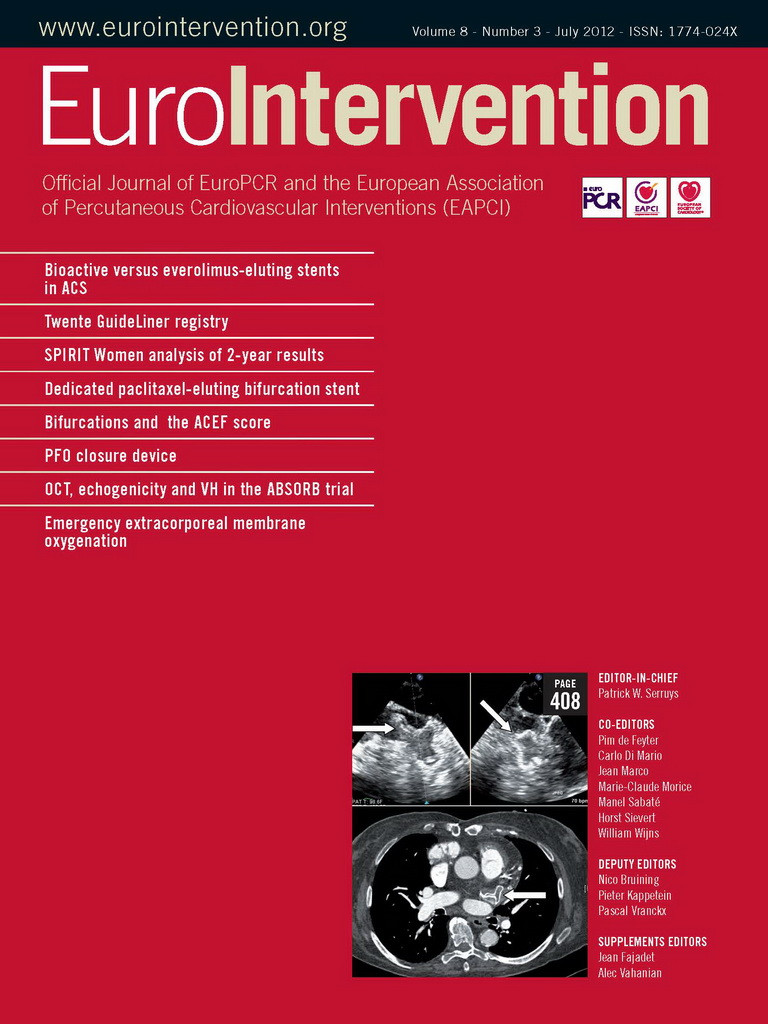Dear colleagues,
Here in Europe the summer is upon us, but far from the summer doldrums we are busily preparing our upcoming editions of EuroIntervention as the complexity and drive of our speciality lead us on through and into the fall. The editorial board is busy considering papers to be published when these summer months are just a memory, but before that, and before we all leave on vacation, there is the August edition of the Journal to prepare, the one that will come out around the time of the European Society of Cardiology meeting in Munich, as well as a supplement on the current state of Stent for Life.
And while the future is very much in our thoughts, there is much to keep us excited in this present issue where we are looking at a wide range of topics, with several articles on bifurcations.
In this edition of EuroIntervention
Pasi P. Karjalainen et al discuss the exciting domain of Bioactive stents with a randomised trial powered for non-inferiority for 12-month MACE between ACS patients randomised to everolimus-eluting and titanium-nitride-oxide-coated bioactive stents (BAS). While the trial demonstrated that BAS is non-inferior to EES for the primary endpoint we invited Hans-Rudolf Baur and Bernhard Meier to give their editorial comments on what they begin by describing as having “intriguing biological properties.
Our second editorial in this issue is from Douglas Fraser et al examining the issues behind guide catheter extensions in a witty, pertinent and well-illustrated essay/editorial. Guide catheters are discussed further in the article by Frits H.A.F. de Man and colleagues who introduce us to the GuideLiner catheter, discussing not only the advantages and success of this device, but describe in detail the still limited number of cases and anatomical situations in which the GuideLiner was not helpful. This may help readers to select suitable cases in their own practice and to avoid device failures.
The complexity of the treatment of bifurcations is a topic that EuroIntervention has touched on many times over the last few years. Many of you will remember –and still refer to– our special supplement dedicated to this subject published several years ago. Still today, coronary bifurcations remain among the most challenging lesions for percutaneous coronary intervention (PCI). Gil et al attempt to address this with their report on a dedicated paclitaxel-eluting bifurcation stent system; BiOSS®.
Despite the complexity of bifurcation lesions and the attention they receive, there is still no simple and effective tool to identify patients with a good prognosis. In the article “Simplifying clinical risk prediction for percutaneous coronary intervention of bifurcation lesions: the case for the ACEF (age, creatinine, ejection fraction) score” Giuseppe Biondi-Zoccai et al explores the use of this score in patients with bifurcation lesions undergoing PCI. While the concept of using the ACEF score is known, having been previously reported, in a smaller population, by Joanna J. Wykrzykowska et al from the LEADERS trial population, the strength of the Biondi-Zoccai article is the population examined which is nearly three times larger than the previous reports, and re-confirms the usefulness of the ACEF score to risk-stratify patients having PCI.
Some last thoughts on our Impact Factor
It is coming, and we are all very excited to know precisely what it will be, but for the moment –at the time we prepare to go to press– it remains unknown. I do not want to deny the tension here at EuroIntervention as we await the response to the question on all our lips. The next time we meet, our Impact Factor will be known, and we hope you will see just how justified we feel about the quality of our publication. Still, we know that without you our readers, without you our reviewers, and above all, without you our authors, who have placed their trust in this journal, we would never have arrived where we are today. And for this we are thankful.
We look forward to your continued participation on this exciting journey, and look forward to seeing many of you at the end of the summer at the ESC.

